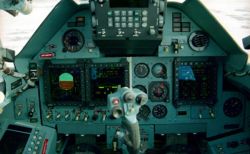US Army Testing Lockheed Martin's Battlefield Intelligence Software
The U.S. Army's primary intelligence system is testing software developed by Lockheed Martin (LMT) that will help them sort through terabytes of intelligence gleaned from manned and unmanned sources, improving their ability to efficiently analyze data.
As part of their ongoing test and evaluation process that includes multiple stages of technology reviews, practical application evaluations and operational user tests, the Army is working with Lockheed Martin to update the Distributed Common Ground System (DCGS-A), as the service prepares for fielding in 2015.
DCGS is a family of systems that enables military analysts from all services to access shared intelligence. DCGS-A takes sensor data from all sources, (signals, imagery and human intelligence) and integrates it into a common data format in a fused environment, making multi-source intelligence analysis possible.
"From drones and satellites to ground sensors and biometric scanners, the amount of information that flows through the DCGS-A enterprise is immense," said Dr. Rob Smith, vice president of C4ISR at Lockheed Martin. "We've worked with the Army to update the software capabilities and make it easier for analysts to expedite the intelligence to those who need it most."
Through multiple projects focused on interoperability, automation and efficient analysis, Lockheed Martin is modernizing how data flows and is connected through the DCGS-A enterprise.
Two new software capabilities are Automated Entity Merge Service (AEMS): AEMS merges similar real-world intelligence data, providing a significant time savings for analysts who are faced with thousands of entities that would otherwise need to be manually reviewed. By automating the merge process, analysts can spend more time analyzing fused results that support understanding the common operating picture.
And DataMover, because DCGS-A is deployed worldwide, often with different versions of software, it is often necessary to convert the data from one format to another so that it can be shared. DataMover converts the data and allows intelligence to be transferred across the DCGS-A enterprise.











